“A visit to a museum is a search for beauty, truth, and meaning in our lives. Go to museums as often as you can.” — Maira Kalman
Draw a Journey Map, All Good Things Will Follow (about Museum Experience)
— New Practices and Perspectives from Shanghai
By Scott Yanshun Cai & Rainie Yu Han
Museums’ value can never be overstated. Throughout the history, almost everywhere, museum experiences successfully drive forward the societal well-being – bringing people together, contributing to local communities and acting as a catalyst for cultural democracy and other positive social changes.
On a sunny morning last winter, we visited German-IFB-designed Shanghai Auto Museum (SAM) and met with a line-up of museum staff and volunteers.
“My day job is a teacher of deaf and hard of hearing,” says Ms. Sun, 33 years old, noting that volunteering at SAM gives herself a chance to practice self-care.
“It’s [usually] only from the visitors at SAM’s Kids Center that I receive ‘normal’ feedback, be it appreciation or explicit need of help,” Sun says. “Hence I am coming to volunteer here almost every weekend.”
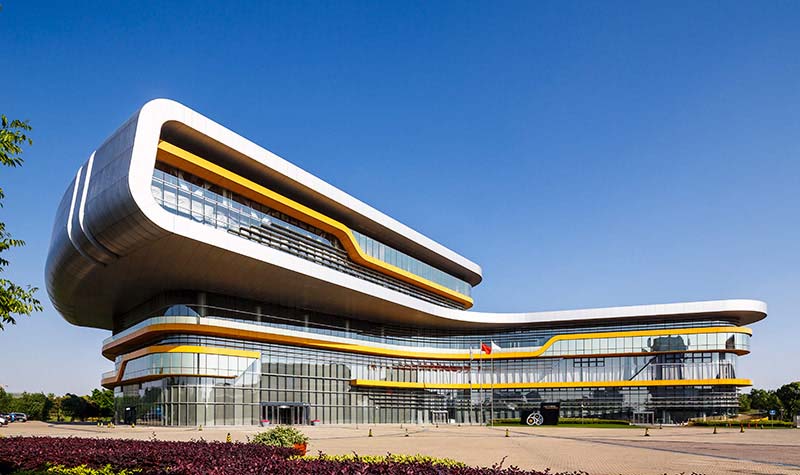
Shanghai Auto Museum.
Journey Mapping as a Design Tool
Ms. Sun is not alone. She’s joined by a cohort of peers with diverse age range, vocation and job position backgrounds who all regularly work as SAM museum volunteers.
Drawing from an inspiring qualitative and quantitative analysis based on dozens of interviews, we’ve sort of ‘seen’ volunteer workers’ meaning-making accounts. Turns out, their experience and job satisfaction is primarily contingent upon several processes: recruiting and placement (personality-job fit), training (up-skilling), in-between break time (social and networking), and end-of-work (lingering emotions). These processes are distinct yet mutually influencing.
That’s also where a magic tool, called ‘user journey map’, comes into the picture.
“Journey mapping can be an effective design tool to understand and communicate the good and bad user/customer experiences of a space,” explains Dr. Mersha Aftab, who is the Director of Birmingham City University’s MA Design Management course, with solid expertise in the industry and corporate consulting as well.
She further elaborates that, typically, journey mapping starts by compiling a series of user actions into a timeline, which then is fleshed out with user thoughts and emotions to create a narrative. “This narrative is condensed and polished, ultimately leading to a form of visualization,” says Dr. Aftab.
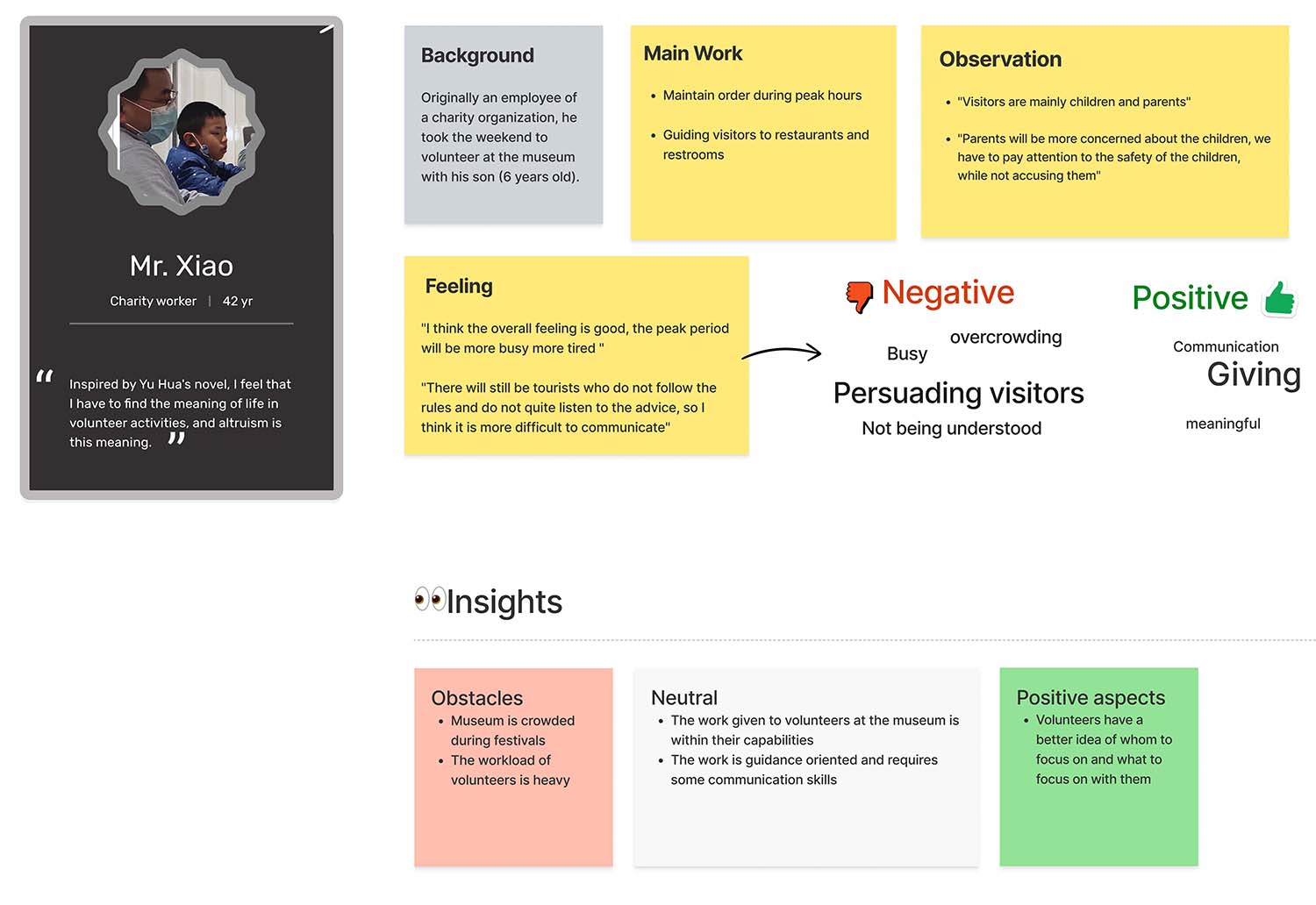
The User Journey Map: A dozen of interviews with volunteers and volunteer managers are conducted to learn more about their stories, personal feelings and problems in volunteer service.
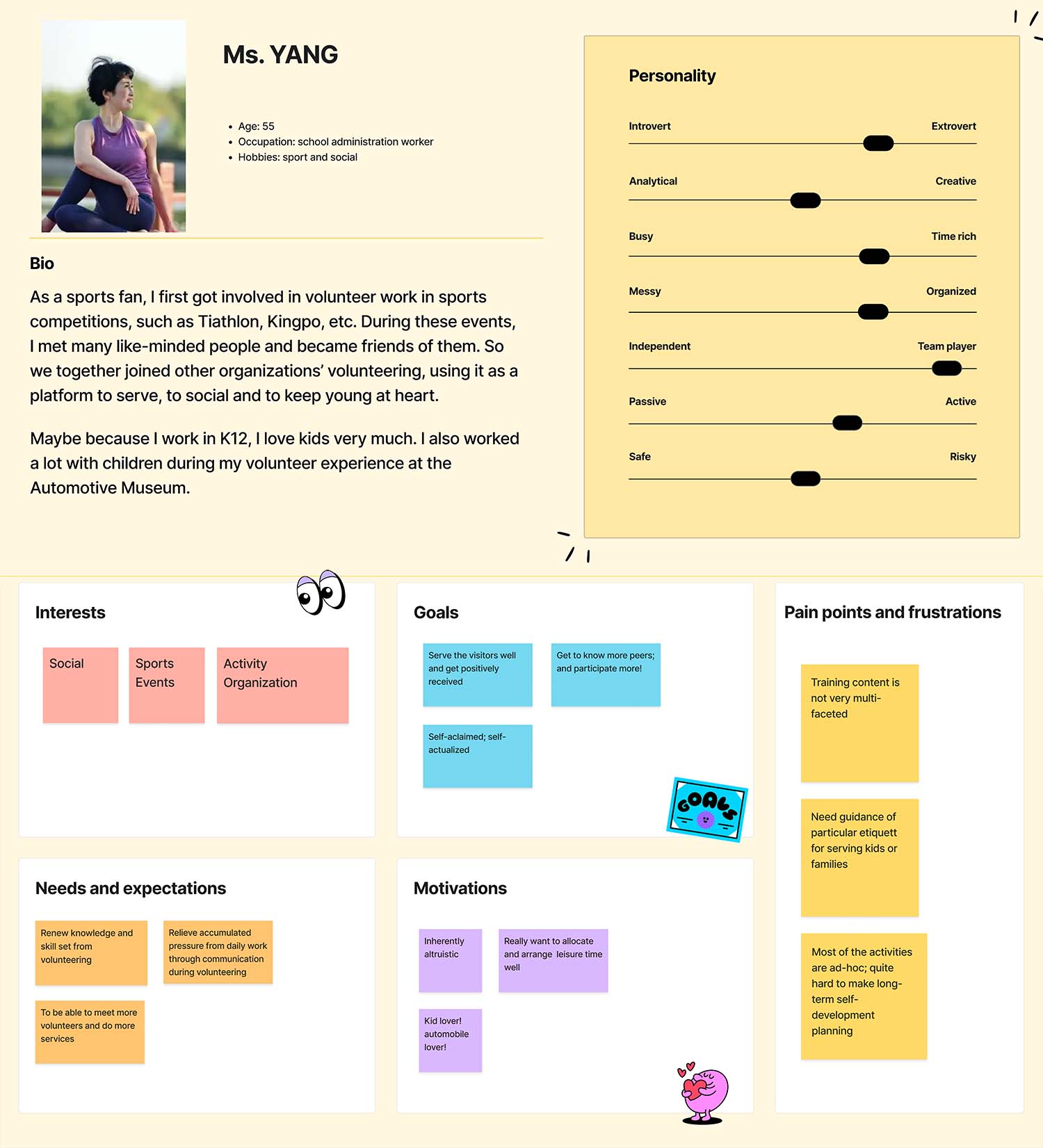
Based on interviews and surveys, we’ve found that our targets — i.e. the museum volunteers — share a very clear personal profile.
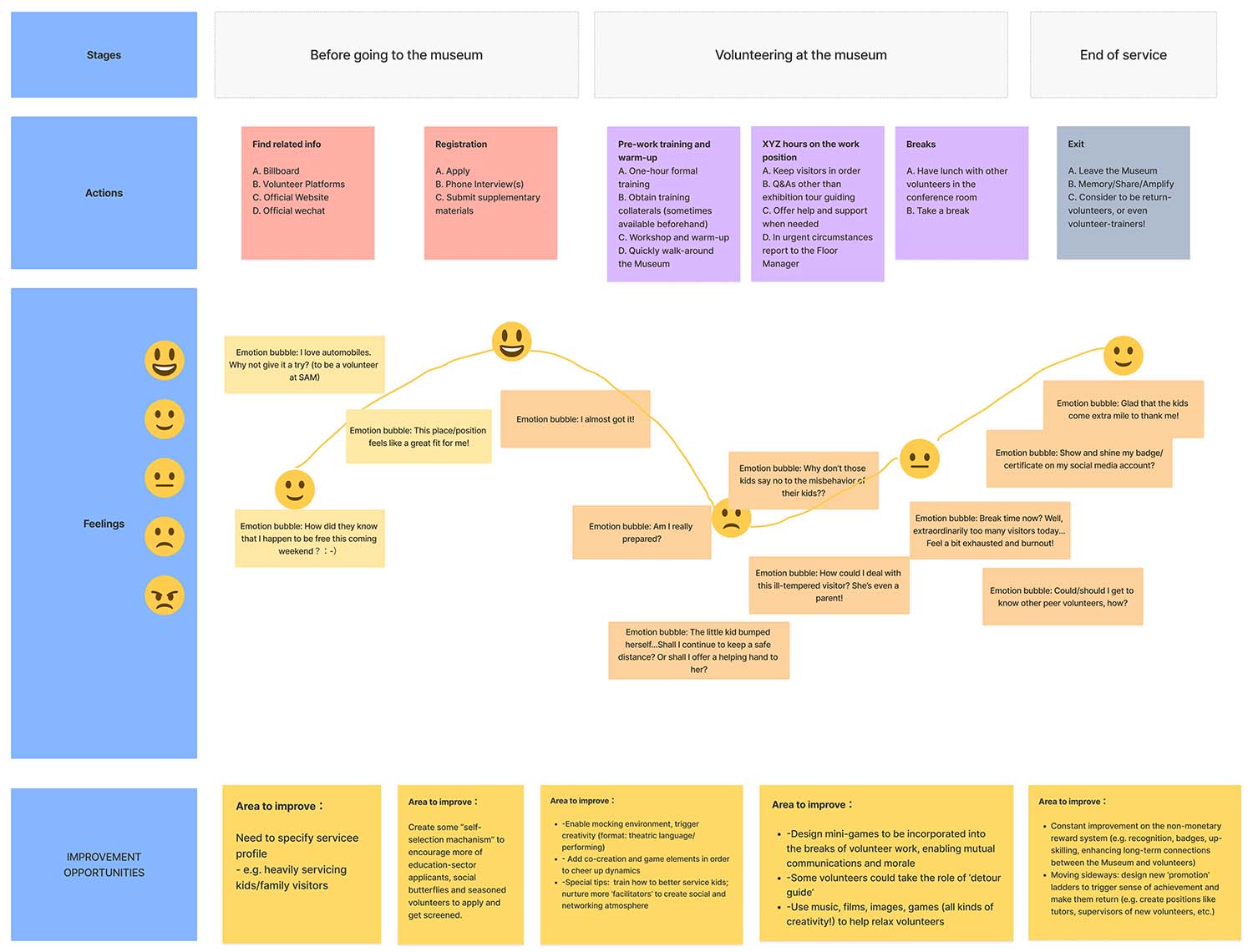
The user journey of a volunteer comes to shape.
A-to-Z Optimization: All Design-led
We worked closely with SAM building upon the insights (i.e. drawn from the journey mapping tool) and trying to optimize the museum’s service design holistically.
Indeed, while undertaking this pro bono Program with the aim to enhance museums’ public services in the city of Shanghai, we are profoundly aware of how distributions of power and culture are constituted via ‘spaces and places’ (e.g. museums).
Academic findings abound to fully support this. An article published by Oxford University Press suggests that ‘humanistic geography’ and ‘spatial studies’ view space-and-place as a product of social relations that maintain a critical, ‘de-essentializing politics’.
Documentary filmmaker and Smithsonian AIB former director Rachel Goslins echoes this by saying that, “Museums are more important than ever because [trust in] other institutions of our society are going down…One of the few places that people trust as a source of information is museums.”
Back to the Shanghai Auto Museum, where we’d intend to better the public service mechanism, the opportunities arise first within the volunteer workforce.
First, to focus on their needs and turn them into returning volunteers, the Museum shall incorporate better ‘self-selection’ in the recruiting and placement phases. Efficient placement of volunteers on the right posts is crucial to creating delightful museum experiences – for both the service-providers and receivers. This is especially true for positions frequently interacting with kid/family visitors, which require more patience and lightheartedness.
Next, from structural design-thinking further to emotional design-thinking: SAM is well in the position to make every minute count, including volunteers’ lunchtime and breakout sessions; mini-games, music, and other creativity (even, as is being examined, improvisational theatre!) are all expected to help relieve volunteers work pressure and fatigue. Adjusted work shifts are being considered to allow for more structured cross-program social opportunities and relationship building. After all, volunteers come to SAM not merely contributing their valuable time and services, but also bringing to their work and teams the fullness of their ‘lived experience’.
In fact, as if to build a climax of the emotional aspects, the Shanghai Auto Museum administration has announced a particularly unique program that allows all qualified volunteers to be treated as visitors for one day.
In London, there’s somewhat a flip-version of such practices. Kids in Museums, a third-party organization advocating for family-friendly museum building, has initiated the Takeover Day since 2010 to facilitate a day in a year when the kids go to all kinds of museums, galleries and other heritage sites to take over jobs normally done by adults.
“And this perfectly ties back to the notion of human centeredness being the core of design thinking, and Shanghai Auto Museum’s endeavor just well exemplifies that,” says Dr. Aftab.
Another university scholar, Evelyn Richardsoni of University of London curatorial management, agrees. Richardson further maintains that the significance of ‘moving sideways’ can never be over-estimated in preventing burnout and keeping a satisfactory retention of SAM volunteers. And rolling out gradually at SAM now is a multifaceted, hall-of-fame system that includes everything ranging from visitor-initiated pay-tribute to score-card ranks.
The various optimizations described above well illustrate the big impact of design-led museum experiences (no matter how tiny they seem). Today’s exhibition environments, just like book author Tiina Roppola would put it, are enticingly complex spaces: as encyclopedic warehouses of cultural heritage; as theaters of drama and leisure activities; as free-choice learning contexts…you name it!
As a further step in our pro bono Program, our Team iteratively improved the journey mapping toolkit – turning it into a general model that could potentially be used for other museums and projects.
By the time of our authoring this article, another heavy-weight museum in Shanghai, i.e. Power Station of Art (PSA), has decided to join our Program. PSAis originally the Urban Future Pavilion of Shanghai Expo (visited by 73 million visitors!); interested in applying our toolkit to their museum operations, PSA is well-positioned to showcase our solutions in a larger context (i.e. World Expo Legacy sites).
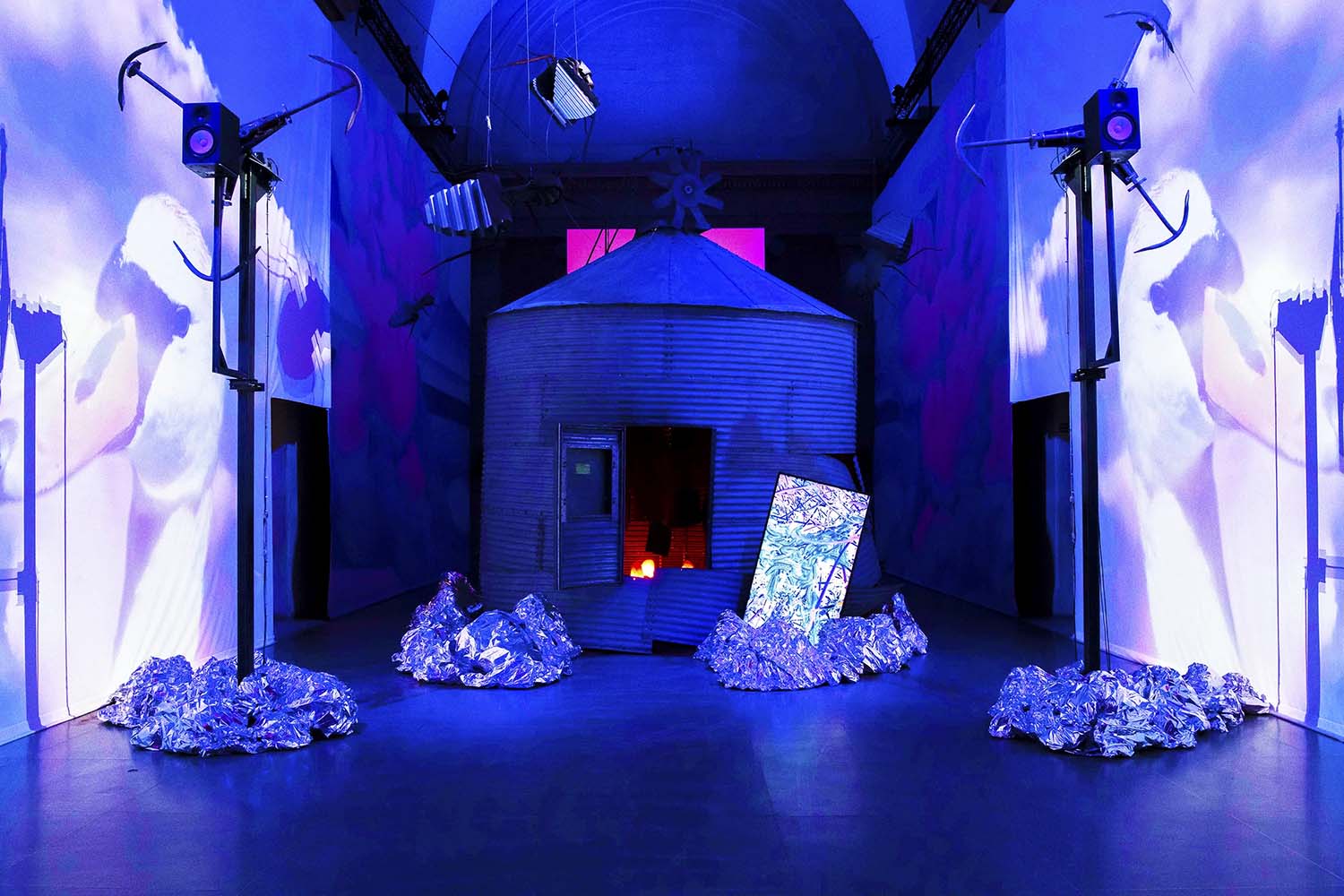
The Turner Prize 2022: Heather Philllipson: Rupture No 1: blowtorching the bitten peach, installation view at the Duveen Galleries, Tate Britain, London, 2021. Image courtesy Tate Galleries and the artist.
Participatory Museum Experience Facilitation
Design thinkers typically tackle problems from a systems view – people, process, place, and technology. Technology – yes! – has the great potential to play an increasingly central role in museum experiences.
PSA, for instance, has adopted location-based intelligence tech to regulate the entrance flows. Staff and volunteers are able to open up new entrances based on real-time visitor flow data.
‘Movement building’, in fact, has a lot to do with participatory activities at museums. Conventionally, museums provide content for visitors to consume. But in recent years there’s been a transformation where museum experiences get ‘decentralized’, along with a blurred continuum of active-passive participation. In other words, a broader set of actors co-produce the experience as content creators, consumers, critics and collaborators. Also, as museum leaders look to the future, they see a shift towards more art activism and aesthetic interventions in social affairs – by all kinds of artistic practices.
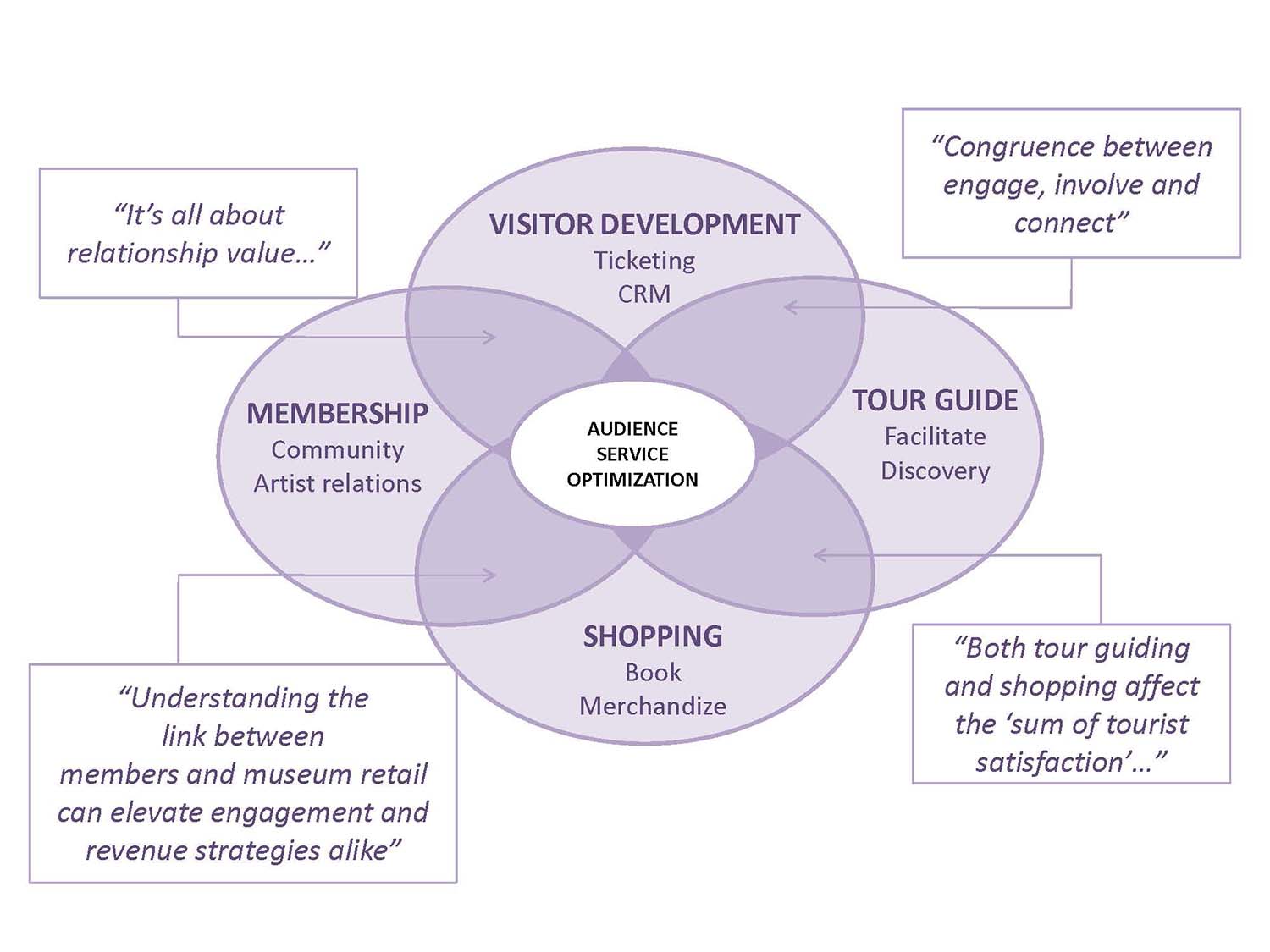
Management issues mapping for Power Station of Art in Shanghai (Image courtesy Scott Yanshun Cai).
Museums can, and indeed should, take full advantage of the creative and intellectual capital that artists bring to the table. After a holistic diagnostic assessment of the institution, University of London’s Evelyn Richardson gives the very advice to PSA.
PSA has been the main organizer, and permanent exhibition location, of the Shanghai Biennale ever since 2012.“There are museums where artists not only participate as exhibiting artists, but also function as designers, planners, educators and advocates.
“Furthermore, the museums can consider offering an artist a residence program or a high-profile award,” Richardson suggests.
One such example has been the Turner Prize. It’s closely related to a group known as ‘Patrons of New Art’, under the directorship of Alan Bowness, who managed to encourage wider interest in contemporary art and assist Tate Gallery in acquiring new works. Believing that Britain should establish its own award for visual arts, an equivalent to the Booker Prize [in the literary realm], they founded the Turner Prize in 1984.
The Turner Prize has nowadays become the UK’s most publicized art award and arguably created an unparalleled win-win: i.e. personal confidence gained from being nominated [by the Prize] – in the words of sociologist, writer, ethnographer Sarah Thornton – is able to “galvanize an artist’s ambitions, while the [Tate] museum’s public endorsement leads to further exhibition opportunities.”
The Bigger Goals
Still, museums in Shanghai today face, in myriad ways, both overt and covert challenges: new visitor development, artist relations, funding avenues, reworking of space-and-place to align their collections and missions, and ever escalating technologic- and sustainability-issues.
Our empirical examination and research passions lie in the intersection of urban economics, culture and sociology. What particularly intrigue us is how cities can develop themselves into hubs of sustainable industries and human capital – and subtly, museums play an incubator role in this.
With sort of the bigger goals in mind to make a unique impact in enhancing urban vitality, we endeavor to use design-thinking engineering to help make museums highly service-oriented institutions in the city of Shanghai. No doubt – our pro bono Program has just started off that meaningful trajectory.
***
About the authors: Scott Yanshun Cai received a 10-week training from Stanford University on design thinking; Rainie Yu Han studied user experience design at the University of British Columbia and graduated with a master degree of digital media. They both like to thank Rock Zou and Michelle X.Y. Zhu for their valuable input as well.
Books, videos, websites and other references for this article:
1. Kaplan, K (2021) UX Mapping Methods: Study Guide. Nielson and Normal Group.
2. Curedale, R (2016) Journey Maps: The tool for design innovation
3. BUYER PERSONA INSTITUTE https://www.buyerpersona.com/example-buyer-persona
4. STRATEGYZER.COM https://strategyzer.com/canvas/value-proposition-canvas
5. Roppola, T (2013) Designing for the Museum Visitor Experience. Routledge.
6. Simon, N (2010) The Participatory Museum. Museum 2.0
7. Ewalt, J (2017) Mapping and Spatial Studies. Oxford University Press.
8. Shoshan, M (2019) Exhibit: Designing for Decentralization. Harvard University Graduate
School of Design
9. Glaeser, E (2022) CitiesX: The Past, Present and Future of Urban Life. Harvard University 10. Hasso Plattner Institute of Design (2022) An Introduction to Design Thinking: Process
Guide. Stanford University
11. KIDSINMUSEUMS.ORG(2023) https://kidsinmuseums.org.uk/what-we-do/takeover-day
12. Savage-Yamazaki, B (2022) The Future of the Museum Experience: Diverse, Inclusive, and
Digital. Gensler Research & Insight.
13. WIKIPEDIA.ORG (2022) https://en.wikipedia.org/wiki/Turner_Prize
* Evelyn H. Richardson is a pseudonym of the lecturer who requests to be anonymous.








